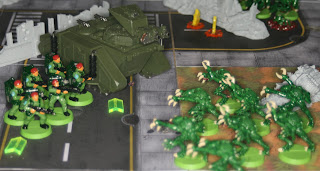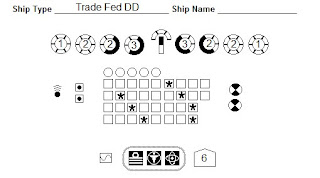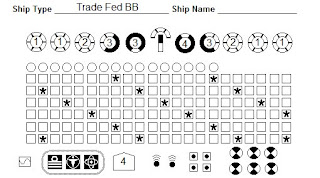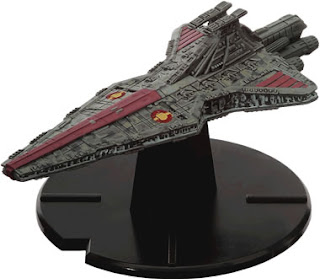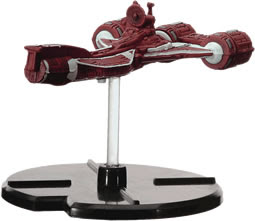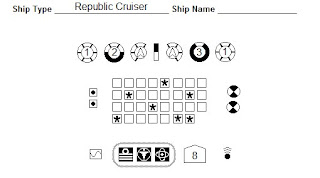However, I thought I would just include a small commentary that might give a feel to how SGII works for those who are not familiar with it. My notes for the game do not generally include the actual dice rolls and scores etc, but there is enough information to reconstruct roughly what happened.
Firstly, just a quick summary of the game differences.
SGII uses alternate squad activation rather than the IGOUGO sequence of 40K. When activated, a unit can perform 2 actions: move, shoot etc. The major restriction is that no weapon may be fired more than once in a given activation. There is no inherent reason one is better than the other and both can certainly provide an interesting narrative. Particularly if you assume that in reality, many things that appear to happen sequentially due to game mechanics actually happen simultaneously.
To play the game solo, I use a chit pull method. In a cup, there is one red chit for each human unit and one for each alien unit including one representing all of the spore mines. When a chit is drawn, I activate a unit from the appropriate side. In this scenario, the aliens received one new unit at the end of each turn, so one extra chit was placed in the cup at the same time.
Thus, early on in the game, there were more human units that aliens, but as the game progressed the numbers balanced out. Similarly, when one unit was removed, or two units merged (as the two gaunts with devourers did late in the game) the number of chits is adjusted accordingly.
The other mechanic that needs mentioning is the opposed die roll. Various capabilities, such as troop quality, weapon firepower or armour class, are rated with a particular die type (d4, d6, d8, d10 and d12). Results are determined by rolling one or more of these dice against a target value set by rolling another die. For example, to convert a ‘hit’ to a ‘kill’ the target rolls a die matching its armour class and the firer rolls a die matching the weapon impact value.
I will begin the commentary at game turn 9, as this is where the crucial action is set up. The diagram below is an attempt to recreate the initial positions.

The tyranid forces are:
1 genstealers
2 termagants with fleshborers
3 termagants with devourers
4 hormagaunts
5 termagants with fleshborers
The two ‘S’ symbols mark approximately where the remaining spore mine nodules were and the ‘H’ marks where the hive node is.
Turn 9.
Cagney shoots at the genestealers scoring 2 hits, but no kills – ie suppression. Scott advanced towards the fleshborers in the archive and shoots with no effect. Flynn also advances and shoots with no effect. The fleshborers return fire against Scott with no effect. Fleshborers in the chapel shoot at Wayne with no effect. The devourers, who had two suppression markers, recover one suppression, but fail the other. Wayne shoots at some nearby spore mines and destroys them. The hormagaunts remove their suppression and advance towards the CP. Gable shoots at the devourers suppressing them again. The genestealers also remove their suppression and advance behind the hormagaunts. The HQ activates and runs away, also ordering Cagney to make a run for it, which they do and both exit the western side of their ruined building.
Comments
The apparent ineffectiveness of the shooting results from two factors. Both lasguns and fleshborers are some of the poorest weapons. The have quite low firepower values and quite low impact values. Most of the terrain is at least ‘cluttered’ and provides an added difficulty to the ‘to hit’ rolls representing obscuration and the buildings also provide a hard cover bonus to armour die rolls.
Shooting works using the opposed die roll method. First a range die is determined based, surprisingly, on the range between target and firer. In the case of the guard firing, the range increment is 8 inches, equel to their quality die type. So at 0-8 inches, the range die would be a d4, at 9-16 inches a d6 etc. If the target is behind some sort of concealment, the die is shifted up by one type. In this example, the range was probably just over 8 inches and the termagants were in a building, so the range die was a d8. The firer then determines their firepower. This is either the sum of the small arms firepower for the sqadd and/ or any support weapons. In the case of Scott's guard squad, there was 6 riflemen, each with a firepower of 1, and a plasma gunner. So the total firepower was 6x1 = 1xd6 plus a d6 for the plasma gun. To this, they add their quality die of a d8. So, I put 2x red d6, 1x red d8 and 1x green d8 in a cup and roll the dice. The red dice have to beat the single green die to have an effect. If one die beats the green one, the target is suppressed, if more than one, then you calculate hits and compare weapon impact vs target armour to calculate kills.
At the end of the turn, the platoon HQ was able to re-activate Cagney’s squad and have them run away from the genestealers. This is one of the features of the rules that I really like. Commanders command. They can spend one action to attempt to communicate with a subordinate unit and have it (re)activate. Because they have two actions, a platoon command can attempt to activate two subordinate squads. This is one of the main ways to differentiate forces – command density or span of command.
In this scenario, the Tyranids had no commanders, and so could not benefit from these extra activations. This will be described in more detail when I post the rules for the Tyranids.
Turn 10.
Gable fired at the hormagaunts shielding the genestealers with no effect (ie rolled tragically low). Wayne also fires on the hormagaunts and kills 1. Cagney uses 2 actions to keep running and makes it to the scriptorium. The genestealers charge Wayne (as he is now the closest enemy squad). In response, Wayne opts to voluntarily fail his reaction test meaning that his squad drops a confidence level (from confident to steady) and withdraws behind Gable. This also means he sacrifices the option to stand and shoot at the genestealers as they charge. Luckily for him, the genestealers roll quite low on the movement dice and do not make contact, leaving them in the open and surrounded by IG weapons. the fleshborers shoot at Scott and suppress his squad. The hormagaunts remove their suppression, but remain in location. The HQ attempts to activate Wayne’s squad again and has them shoot at the genestealers. It also tries to reactivate Gable, but fails the comms roll. Wayne scores 3 kills (the first against the genestealers) and they pass their reaction test.
Arguably, here, they might have preferred to fail and withdraw behind cover. Unlike the reaction to charging, the rules do not permit voluntary failure from shooting, but this ought to be considered.
Scott recovers from his suppression and continues shooting. The devourers recover one suppression marker again, but still have one. And Flynn continues to advance and shoot.
Comments
I fully expected the genestealers to reach the stormtroopers and wipe them out and it seemed, given the positions at the time, the most likely thing for them to do. in fact, at the beginning of the turn, I was concerned because there were three guard units well within range of the genestealers and it didn’t look likely they would all get away.
I did not note the exact distances etc, but the genestealers roll 2d8x2 for movement, giving them the potential to cover 32 inches. The storm troopers could not have been 20 inches away even after they withdrew a bit. This would have a significant effect on the battle as only the storm troopers were equipped with the melta-bombs necessary to destroy the hive node. Krak grenades have a small chance of succeeding.
As it was, the combination of firepower and a bit of luck saved the guard.
Turn 11.
Gable shoots at the genestealers and kills 4. They continue to stand/ threaten, but have 2 suppression markers in total. The hormagaunts charge the HQ, but don’t quite make the distance. Wayne shoots at the genestealers and kills the last ones. Cagney shoots at the hormagaunts, killing 1. The HQ orders Cagney to keep shooting and they take a shot themselves with no effect. Cagney’s fire kills another hormagaunt. Scott and Flynn and the fleshborers continue suppressing one another.
Comments
At this point, the genestealers are dead and the remaining 4 broods of gaunts are at less than half strength. The hormagaunts are in the open and will probably be shot to pieces before they can recover from their suppression and charge again. The other broods will stay hidden amongst the protection of the ruins but are too ineffective to stop the guardsmen from mopping them up.
Overall, I was pretty happy with how both armies played. The guards mostly stuck with the plan of using their firepower to suppress the tyranids and stop them getting close. The genestealers using the hormagaunts as a shield seemed likely and almost worked twice.
The dice seemed to work evenly against both sides. Early on, Scott’s squad kept rolling very low for movement and hence took far to long to get to the second mine nodule and when they finally did, they took three goes to destroy it, losing 2 or 3 guys in the process. (Sgt Scott was subsequently shot for incompetence) The spore mines themselves were not all that effective, apart from the lucky one that damaged Clarke’s Razorback leaving him at the mercy of the nearby hormagaunts. Their main job was just to slow down the guards and give them something else to worry about occasionally.
So, stay tuned for the actual rules.

